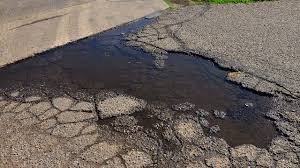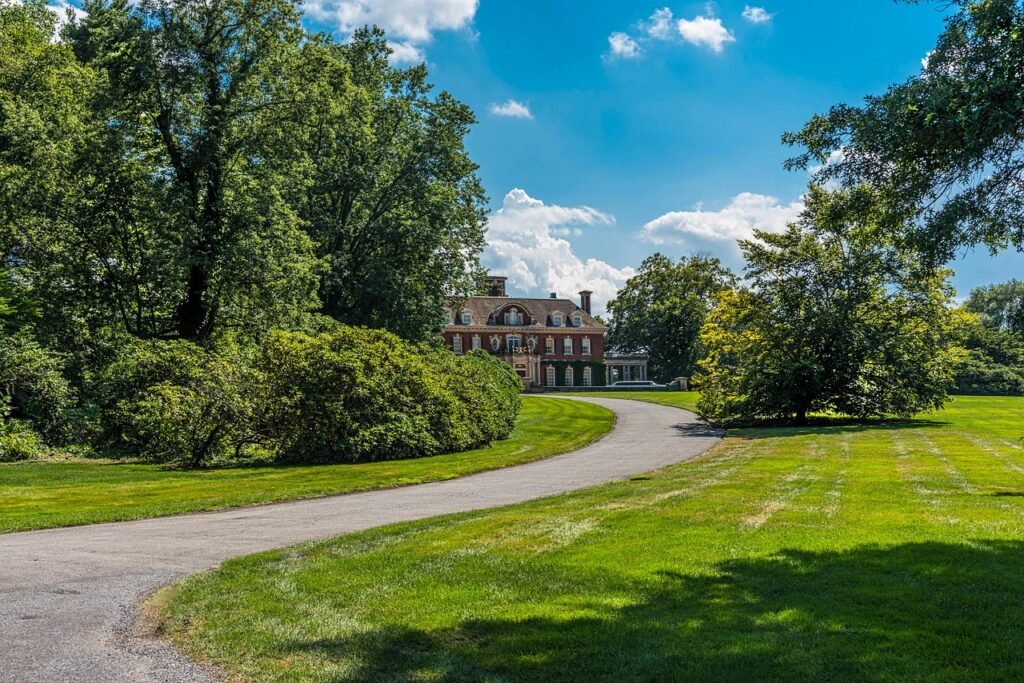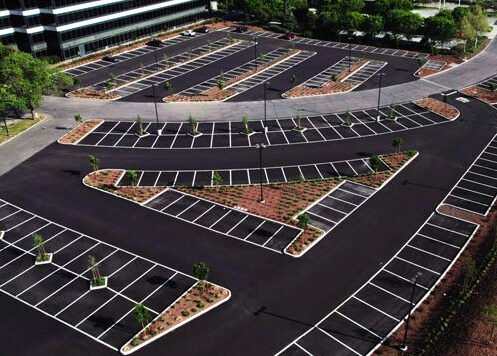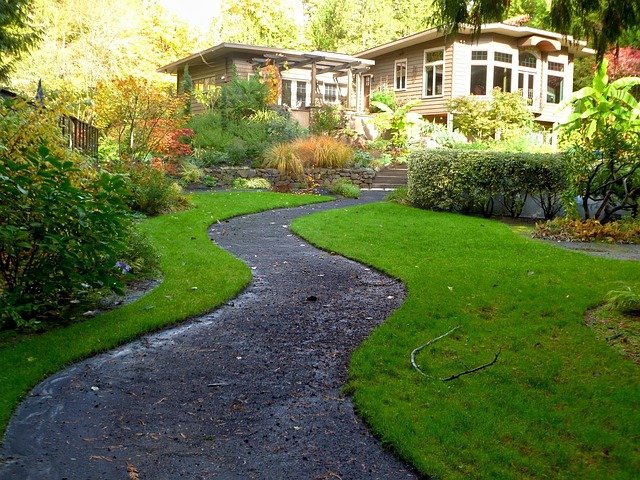How Proper Drainage Design Impacts Asphalt Driveway Longevity
Asphalt driveway drainage design is the single most critical factor determining your pavement’s lifespan. In my 15+ years installing residential and commercial surfaces, I’ve witnessed countless premature failures caused by driveway drainage problems. Here’s a critical fact: driveways with poor water management fail 60% faster than those with proper drainage installation.
Most homeowners don’t realize that professional driveway drainage design can double their pavement’s lifespan. The difference between a 10-year failure and a 25-year surface often comes down to how effectively you prevent asphalt driveway water damage.
This expert guide reveals asphalt driveway longevity strategies that protect your investment and eliminate costly repairs permanently.
Check our Drainage Slope Calculator for accurate calculations for your project.
The Hidden Science of Water Damage
How Water Destroys Asphalt Surfaces
Water infiltration begins the moment your driveway develops its first hairline crack. These seemingly minor imperfections become entry points for moisture that wreaks havoc on the entire pavement structure.
Freeze-thaw cycles create devastating expansion forces. Water expands 9% when it freezes, generating pressures up to 50,000 pounds per square inch. This force splits asphalt and concrete with ease.
Base material saturation weakens the foundation beneath your driveway. Saturated aggregate loses 80% of its load-bearing capacity, leading to rutting, cracking, and eventual failure.
Subgrade soil instability develops when water reaches the prepared soil beneath your driveway. Asphalt driveway drainage problems clay soil situations create particularly challenging conditions where expansive soils cause significant movement.
The True Cost of Drainage Neglect
Premature replacement costs average $8,000-15,000 for typical residential driveways. Compare this to $800-2,000 for proper drainage installation during initial construction.
Progressive damage follows predictable patterns. Year 1-2: minor surface cracks appear. Year 3-5: edge deterioration accelerates. Year 6-8: structural failure requires complete reconstruction.
Property value impact can be significant. Real estate agents report that failed driveways reduce home values by $3,000-8,000 during sales negotiations.
Hidden damages include foundation problems, landscape erosion, and basement water issues that develop from poor asphalt driveway drainage design.
Understanding Drainage Fundamentals
Natural Water Movement Principles
Gravity drives all drainage design decisions. Water always seeks the lowest point through the path of least resistance.
Surface runoff calculations determine subsurface drainage systems sizing. The formula: Runoff = Rainfall Intensity × Area × Runoff Coefficient. For asphalt surfaces, use 0.95 as the runoff coefficient.
Subsurface water movement follows different rules. Groundwater flows horizontally through soil layers, potentially undermining asphalt driveway longevity.
Seasonal water tables fluctuate based on precipitation and soil conditions. Design drainage systems for peak water table conditions, not average levels.
Critical Drainage Zone Identification
Surface drainage handles rainwater that falls directly on the driveway. This represents 70-80% of total water management needs in proper drainage installation.
Edge drainage intercepts water flowing toward the driveway from adjacent areas. Neglecting edge drainage causes 40% of driveway drainage problems.
Subsurface drainage manages groundwater and water that penetrates the surface. This system prevents base saturation and subgrade instability in professional driveway drainage design.
System integration connects your driveway drainage to existing storm sewers, ditches, or natural drainage patterns.
Surface Drainage Design Mastery
Slope Requirements and Implementation
Minimum slope standards require 2% grade for effective drainage. This translates to 1/4 inch of fall per foot of driveway length in asphalt driveway drainage design.
Cross-slope design moves water from the center to edges. Use 1-2% cross-slope for most residential applications to prevent asphalt driveway water damage.
Longitudinal slope carries water along the driveway length. Maintain consistent grades without creating water collection points.
Flat terrain solutions require creative approaches. Consider drainage inlets, permeable materials, or slight crowning to achieve positive drainage and improve asphalt driveway longevity.
Crown Design Strategies
Single crown configuration works best for driveways under 16 feet wide. Center the high point and slope to both edges for optimal drainage design.
Double crown design suits wider driveways and those with median strips. Create two high points with valley drainage between sections.
Crown height specifications typically range 1-3 inches for residential driveways. Calculate based on width and desired slope percentages in your proper drainage installation.
Landscape integration ensures crowns blend naturally with existing grades. Avoid abrupt transitions that create maintenance problems.
Advanced Surface Water Management
Sheet flow promotion spreads water evenly across surfaces. This reduces erosion and prevents channeling that damages pavement edges.
Concentrated flow control manages water volumes exceeding sheet flow capacity. Install drainage channels or swales at strategic locations.
Catch basin placement intercepts water before it reaches critical areas. Size basins for 10-year storm events minimum in professional driveway drainage design.
Outlet design safely conveys water away from the driveway area. Ensure adequate capacity and proper energy dissipation.
Subsurface Drainage Systems Excellence
Base Layer Water Management
Aggregate base specifications must balance strength and drainage. Use well-graded stone with 8-12% fines content for optimal performance in asphalt driveway drainage design.
Perforated pipe installation requires precise placement and grading. Install pipes 6-12 inches below the base layer with 1% minimum slope.
French drain integration captures water entering the base layer. Surround pipes with clean stone and geotextile fabric wrapping.
Base material gradation affects drainage performance significantly. Avoid poorly graded materials that create impermeable layers and cause driveway drainage problems.
Edge Drain Implementation
Installation timing occurs during base preparation. Never attempt to retrofit edge drains without full reconstruction.
Proper depth placement positions drains 12-18 inches below finished grade. This intercepts water before it reaches critical areas in subsurface drainage systems.
Slope requirements demand 0.5% minimum gradient toward outlets. Use laser levels for accurate installation.
Maintenance access planning prevents future problems. Install cleanouts every 100 feet and at direction changes.
Subgrade Preparation Excellence
Soil compaction standards require 95% standard Proctor density. Rent pneumatic compactors for proper densification.
Geotextile applications separate base materials from subgrade soils. This prevents pumping and maintains drainage capacity.
Subgrade stabilization addresses problem soils proactively. Use lime or cement treatment for asphalt driveway drainage problems clay soil conditions.
Problem soil identification requires professional testing. Don’t guess about soil conditions on critical projects.

Common Drainage Design Failures
Installation Errors That Destroy Driveways
Inadequate slope creation causes water ponding and accelerated deterioration. Many contractors underestimate slope requirements in asphalt driveway drainage design.
Poor base selection using non-draining materials creates bathtub effects. Always specify open-graded base aggregates.
Insufficient compaction allows settlement that creates low spots. These areas collect water and fail prematurely, reducing asphalt driveway longevity.
Improper tie-ins to existing drainage create bottlenecks. Survey and upgrade downstream systems as needed.
Design Oversights and Consequences
Uphill water sources often get ignored during planning. Consider roof drainage, landscape irrigation, and natural flow patterns.
Undersized components fail during peak flow events. Design for 25-year storms in residential applications.
Maintenance access neglect makes future repairs expensive. Plan access routes for cleaning and maintenance equipment.
Future change considerations should influence initial proper drainage installation. Account for landscape maturation and property modifications.
Regional Climate Adaptations
Cold Climate Drainage Strategies
Frost heave prevention requires drainage below frost line depths. Install insulation layers where necessary to maintain asphalt driveway longevity.
Winter maintenance planning includes snow removal access and ice dam prevention. Design drainage outlets away from walking surfaces.
Freeze-thaw mitigation uses flexible materials and joints. Allow for thermal movement without compromising drainage design.
Insulation techniques protect critical drainage components. Use rigid foam insulation around pipes in extreme climates.
Hot Climate Considerations
Thermal expansion accommodation prevents drainage component damage. Use flexible connections and expansion joints.
Flash flood design handles intense, short-duration storms. Size subsurface drainage systems for local precipitation extremes.
Drought-related movement affects clay soils significantly. Design drainage to handle both wet and dry soil conditions.
Heat stress management protects asphalt from softening damage. Proper drainage installation reduces temperature-related distress.
Wet Climate Solutions
High water table management requires deep drainage systems and waterproofing. Consider dewatering during construction.
Continuous saturation protection uses redundant drainage paths. Design multiple outlets and overflow routes.
Vegetation control prevents root intrusion and system clogging. Use root barriers around drainage components.
Extended flow management handles prolonged wet periods. Size storage and conveyance for extended storm events.
Professional Installation Cost Analysis
Subsurface Drainage Installation Cost Breakdown
Material expenses typically range $3-8 per linear foot for subsurface drainage systems. Quality components provide better long-term value.
Professional installation labor averages $8-15 per linear foot depending on complexity and regional rates.
Equipment rental adds $200-800 for DIY installations. Consider this when comparing professional vs. DIY approaches.
Permit and inspection fees range $100-500 depending on local requirements for professional driveway drainage design.
Long-term Value Calculations
Extended lifespan benefits double typical driveway life from 12-15 years to 25-30 years. This represents $400-800 annual savings.
Reduced repair frequency eliminates emergency fixes and minor maintenance. Proper drainage installation prevents 80% of common driveway problems.
Property value protection maintains curb appeal and functionality. Well-designed systems add $2,000-5,000 to home values.
Insurance considerations may include reduced premiums for proper water management. Check with providers about potential discounts.

Materials and Equipment Guide
Affiliate Link Disclaimer: This post contains affiliate links. We may earn a commission if you purchase through these links, at no additional cost to you. This helps support our content creation.
Essential Drainage Materials
Perforated Drainage Pipe – 6″ HDPE corrugated pipe provides excellent flow capacity and durability. Order 10% extra for fittings and waste.
Drainage Aggregate – #57 stone offers optimal drainage while maintaining stability. Avoid limestone in areas with acidic soil conditions.
Geotextile Fabric – Non-woven landscape fabric prevents soil migration while allowing water flow. Choose 4-6 oz weight for most subsurface drainage systems.
Catch Basin Systems – Plastic or concrete catch basins handle surface water collection. Size based on drainage area calculations.
Professional Installation Tools
Laser Level – Rotary laser systems ensure accurate slopes and grades. Essential for proper drainage installation.
Plate Compactor – Walk-behind compactors achieve required soil densities. Rent larger units for extensive projects.
Trenching Equipment – Mini excavators or trenchers create precise drainage channels. Consider rental for DIY projects.
Grade Stakes – Wooden or metal stakes maintain proper elevations during construction. Use bright colors for visibility.
Testing and Quality Control
Density Testing Equipment – Nuclear or sand cone testing verifies compaction standards. Required for warranty compliance.
Flow Testing Tools – Water level indicators confirm drainage system function. Test before final paving.
Soil Testing Kits – pH and classification tests identify problem soils early. Essential for asphalt driveway drainage problems clay soil situations.
Our Most Popular Calculator Categories
Professional vs DIY Installation Guide
When Professional Help is Essential
Complex topography requires engineering analysis and sophisticated solutions. Don’t attempt steep or irregular sites without expertise in professional driveway drainage design.
Municipal requirements often mandate professional design and installation. Check local codes before starting any drainage work.
Large-scale projects benefit from professional equipment and experience. Consider projects over 2,000 square feet as professional-grade.
Clay soil conditions demand specialized knowledge and treatment methods. Asphalt driveway drainage problems clay soil situations require professional assessment.
DIY Project Feasibility Assessment
Simple slope projects with straightforward drainage can be DIY-friendly. Limit attempts to small, uncomplicated driveways.
Equipment accessibility makes professional tools available through rental. Budget $200-500 for equipment rental on typical projects.
Permit navigation varies by location and project scope. Research local regulations before beginning work.
Skill development requires time and practice. Consider smaller test projects before tackling primary driveways.
Contractor Selection for Drainage Projects
Drainage-specific experience matters more than general paving experience. Ask for asphalt driveway drainage design portfolio examples.
Licensing verification ensures legal compliance and insurance coverage. Check state and local licensing databases.
Reference validation reveals real-world performance data. Contact recent customers about long-term satisfaction with drainage systems.
Total cost evaluation should consider lifecycle expenses, not just initial pricing. Quality installation pays dividends over time.

Maintenance and Monitoring Excellence
Seasonal Inspection Protocols
Spring assessments focus on winter damage evaluation. Look for new cracks, settlement, or drainage blockages affecting asphalt driveway longevity.
Summer monitoring checks for heat-related distress and vegetation growth. Clear drainage outlets and trim overhanging plants.
Fall preparation removes debris and prepares systems for winter. Clean catch basins and inspect pipe outlets.
Winter observations identify ice dam formation and drainage freezing. Plan spring repairs based on winter performance.
Preventive Maintenance Excellence
Surface cleaning prevents debris accumulation in drainage systems. Use pressure washing annually for optimal performance.
Vegetation management keeps roots away from drainage components. Maintain 3-foot clearance around all drainage infrastructure.
Crack sealing prevents water infiltration through surface defects. Address cracks promptly to prevent asphalt driveway water damage.
Outlet maintenance ensures free-flowing discharge points. Remove sediment and vegetation from outlet areas regularly.
Troubleshooting Common Drainage Issues
Surface ponding diagnosis indicates slope problems or drainage blockages. Address immediately to prevent structural damage.
Edge deterioration analysis suggests inadequate edge drainage. Install or upgrade edge drainage systems before complete failure.
Settlement pattern evaluation reveals base or subgrade instability. Investigate drainage system performance and soil conditions.
Recurring crack assessment in specific areas indicates ongoing water problems. Comprehensive drainage evaluation may be necessary.
Advanced Drainage Technologies
Smart Monitoring Systems
Wireless sensor networks track drainage performance and alert owners to problems. Real-time data improves maintenance timing.
Automated maintenance includes self-cleaning catch basins and remote valve control. These systems reduce long-term maintenance costs.
Performance analytics identify trends and predict maintenance needs. Data-driven approaches optimize asphalt driveway longevity.
Integration capabilities connect with existing home automation systems for comprehensive monitoring.
Sustainable Drainage Practices
Bioswale integration treats runoff while managing flow. These systems improve water quality and provide aesthetic benefits.
Permeable paving options reduce runoff volumes in appropriate applications. Consider for low-traffic areas.
Rain garden connections manage overflow and provide landscape enhancement. Design for both function and beauty.
Water harvesting captures runoff for irrigation use. Sustainable approaches reduce environmental impact.
Case Studies and Proven Results
Successful Implementation: Clay Soil Challenge
Project Background: 400-foot residential driveway with severe asphalt driveway drainage problems clay soil conditions and steep grades.
Design Solution: Integrated surface and subsurface drainage systems with French drains, catch basins, and proper grading.
Installation Process: Professional excavation, specialized base installation, drainage component placement, and comprehensive testing.
Long-term Results: 12 years of trouble-free performance with minimal maintenance requirements and extended asphalt driveway longevity.
Homeowner Testimonial: “Best investment we made in our property. No more water problems or expensive driveway repairs.”
Cost Analysis: $3,200 drainage investment prevented estimated $12,000 in premature replacement costs.
Common Failure Analysis: Poor Initial Design
Original Problem: Driveway installed without drainage design consideration on sloped lot with clay soil.
Failure Timeline: Year 1: minor cracking. Year 3: significant rutting. Year 5: complete reconstruction required.
Root Causes: No subsurface drainage systems, inadequate slope, poor base material selection.
Corrective Actions: Complete removal, proper drainage installation, quality base materials, professional grading.
Financial Impact: $14,000 total cost vs. $2,800 for initial professional driveway drainage design.
Prevention Lessons: Proper drainage installation costs 15% of repair expenses and prevents asphalt driveway water damage.
Key Takeaways for Maximum Longevity
- Asphalt driveway drainage design can double pavement lifespan from 12-15 years to 25-30 years
- Driveway drainage problems cause 60% of premature failures through base saturation and freeze-thaw damage
- Professional drainage installation costs 10-20% of total project expense but prevents 80% of future problems
- Surface and subsurface drainage systems work together – neither alone provides complete protection
- Asphalt driveway drainage problems clay soil situations require specialized design and treatment approaches
- Preventive maintenance extends system life and protects your investment in asphalt driveway longevity
- Subsurface drainage installation cost shows 3-7 year payback through reduced repairs and extended lifespan
- Quality materials cost more initially but provide superior long-term performance and value
Frequently Asked Questions
Q: How much slope does my driveway need for proper drainage?
A: Minimum 2% slope (1/4 inch per foot) for effective water movement in asphalt driveway drainage design. Steeper slopes may require energy dissipation measures.
Q: Can I add drainage to an existing driveway?
A: Surface drainage improvements are possible, but subsurface drainage systems require reconstruction. Plan proper drainage installation during initial construction for best results.
Q: What’s the most common drainage mistake homeowners make?
A: Neglecting edge drainage from adjacent areas. Many focus only on surface water while ignoring driveway drainage problems from surrounding slopes.
Q: How do I handle asphalt driveway drainage problems clay soil conditions?
A: Clay soils require specialized treatment including proper compaction, geotextile separation, and deeper subsurface drainage systems. Professional assessment is recommended.
Q: What does subsurface drainage installation cost typically?
A: Subsurface drainage installation cost ranges $8-15 per linear foot professionally installed, with materials adding $3-8 per foot depending on complexity.
Q: How often should I inspect my drainage systems?
A: Quarterly inspections catch problems early and maintain asphalt driveway longevity. Pay special attention after heavy storms and seasonal transitions.
Q: Is professional drainage design worth the investment?
A: Absolutely. Professional driveway drainage design costs represent 5-10% of total project expense but prevent asphalt driveway water damage costing 3-5 times the original investment.
Q: What drainage materials provide the longest service life?
A: HDPE pipes, quality aggregate, and non-woven geotextiles provide 25+ year service lives with proper drainage installation.
Q: Can poor drainage affect my home’s foundation?
A: Yes. Inadequate asphalt driveway drainage design can direct water toward foundations, causing settlement, cracking, and basement flooding issues.
Q: How do I troubleshoot common drainage issues myself?
A: Start with visual inspection for surface ponding, edge deterioration, and outlet blockages. Complex driveway drainage problems require professional diagnosis and repair.







